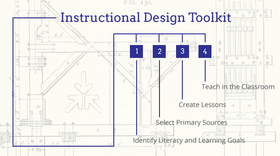Primary Source Exemplar: The Moon
Learning Objectives
Students will be able to:
Identify two or three-dimensional shapes
Draw two or three-dimensional shapes
Create a composite shape and compose a new shape from the composite shape
Partition circles and rectangles into two and four equal shares
Standards addressed:
Math CCSS, Geometry 1.G. Reason with shapes and their attributes
Distinguish between defining attributes (e.g., triangles are closed and three-sided) and non-defining attributes (e.g., color, orientation, overall size); build and draw shapes to possess defining attributes.
Compose two-dimensional shapes (rectangles, squares, trapezoids, triangles, half-circles, and quarter-circles) or three-dimensional shapes (cubes, right rectangular prisms, right circular cones, and right circular cylinders) to create a composite shape, and compose new shapes from the composite shape.1
Partition circles and rectangles into two and four equal shares, describe the shares using the words halves, fourths, and quarters, and use the phrases half of, fourth of, and quarter of. Describe the whole as two of, or four of the shares. Understand for these examples that decomposing into more equal shares creates smaller shares.
Mathematical practice:
Make sense of problems and persevere in solving them
Reason abstractly and quantitatively
Construct viable arguments and critique the reasoning of others
Model with mathematics
Use appropriate tools strategically
Attend to precision
Look for and make use of structure
Look for and express regularity in repeated reasoning
Materials Needed:
- NASA video clip http://www.nasa.gov/externalflash/apollo11_40/
- Paper and pencils to show their mathematical thinking
- 3-dimensional shapes, 2-dimentional shapes
Procedures:
a. Show the following video clip: http://www.nasa.gov/externalflash/apollo11_40/
b. After watching the video clip on Apollo 11, discuss the science content connecting back to what they have learned in previous lessons. Ask students if they saw any of the shapes that you have in front of you. Call on students to come up and hold up each shape they saw.
c. Ask students to describe each shape as they hold it up for the class and help them build their mathematical vocabulary including the names of the shapes you would like them to focus on and simple terms such as plane, face, line, edge, straight, curve, and corner (or vertex or vertices).
d. Have students review the defining attributes of the 2- and 3- dimensional shapes they have selected.
e. Let them watch the short clip again and have them focus on looking for 2- and 3- dimensional shapes.
Note: Teacher may want to periodically stop the video clip for students to get a good view and for class discussion. Above are prints of some of the video clip with various shapes student may identify. Teacher should ask questions to clarify thinking of students. Students need to justify their thinking about the defining attributes of the shapes. What is the difference between defining and non-defining attributes?
f. Students should then build or draw some of the shapes they saw in the video. They then get with a partner using their shapes to create a composite shape. Could their composite shape be seen in outer space? Students should again be able to talk about the defining and non-defining attributes of their composite shape.
Assessment
Students will draw something from the video using some of the shapes they saw in the clip. Have them write a couple of sentences about their drawing and highlight the shapes within their drawing. Help students label their shapes. (It would help to have labelled drawings of shapes on the board for reference).
